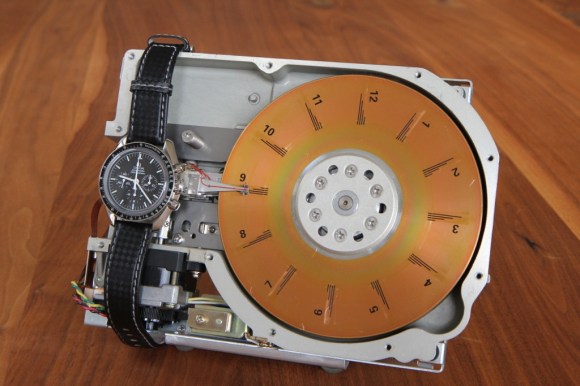
[Martin Stromer] made this great looking Hard Disk Clock about 12 years ago, and finally decided to share it with the world. It’s been “ticking” ever since.
It’s a beautiful clock, and if you think the drive might look a bit odd, that’s probably because its well over 20 years old! We’re not too sure the capacity, but it couldn’t have been more than a few dozen megabytes.
To read the time, the platter rotates 30 degrees at once, per hour. The read-write head inches across the disc to display the minutes. Each of the black lines represents a quarter hour. The whole thing is controlled by an ATMega16, which maintains almost all of the original hardware. The blog post has a great write-up on how it all works.
Did we mention it’s also easy to set the time? Simply rotate the disc by hand and slide the read-write head into place, then press the reset button. Check out the clock in action after the break.
http://www.youtube.com/watch?v=tSaW8k3-mBI
Have an extra hard disk lying around? This is just one great example of a way to repurpose it into something useful! We’ve also seen hard disk grinders before, hard disk DJ scratch pads, and even a cotton candy spinner.
[via HackedGadgets]














Wow… it’s just good to see an old disc drive with a linear actuator!
I hope it’s a reversible hack – that’s an antique.
even if the hard drive is an antique it may be more valuable as an art-deco clock
I absolutely agree. Fantastic hack!
If you read the article you’ll see that the disc head has left marks on the platter. That and the fact the platter has been exposed to the environment pretty much negates any possibility of reversing the changes even if one wanted to.
Yes, but you’d be surprised what those old units could tolerate. Flying height was so high that even opening in ambient would be reversible (done it!).
I had an old 700 Meg (1988ish) at the time, it was at the end of the life but I still used it. I had to leave the computer on all the time as if the hard disk stopped spinning. The motor didn’t have enough umph to spin the platter. Believe it or not, I had to lift the cover, give the platter a spin and put the cover back on. It worked!
Wow. That’s a thing of beauty. And a video where you don’t have to wait for 5 minutes before actually seeing something cool.
A few hundred?? Try 5 or 10MB! I have seen some early 3.5″ full height hard drive that used separate hard drive interface board and 20 pin cable plus 34 pin cable. It used stepper motor on the outside rather than inside so it was subject to problems.
The peak capacity for those was either 20 or 40 Mb. Not more,
Theories on how he got the markings on the platters? Some sort of silkscreening? It looks very clean.
Looks like toner applied by the usual method.
No bit-rot after 12 years, demo mode still works?! That’s got to be some kind of record. I’m struck, too, by how beautiful the innards of a hard drive are (or were).
I believe that Atmel rates that component for at least 20 years memory retention. That’s just off the top of my head. Not sure if their components had different specs 12 Years ago.
>Data retention: 20 years at 85°C / 100 years at 25°C.